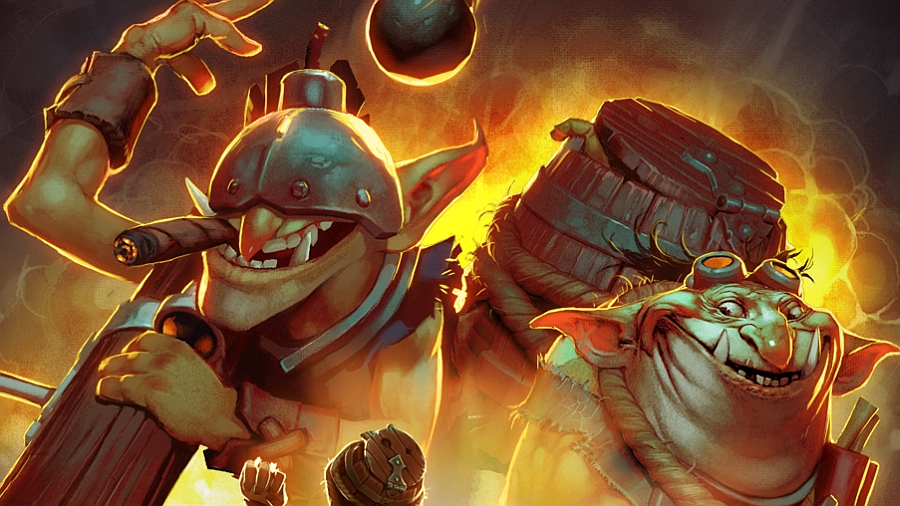Techies, disarmed: the trouble with Dota's most disruptive hero

Every week, Chris documents his complex ongoing relationship with Dota 2, Smite, and wizards in general.
I had one of those Techies games yesterday. You know the one: you're the only support in your pub game, the other team locked Techies late, and now you're going to spend fifty minutes to an hour of your precious human lifespan buying and placing sentry wards. Remember playing Dota with items other than arcane boots and a magic wand? Me neither.
I got lucky in this instance. My random teammates were friendly and understanding, albeit not to the extent of buying wards themselves. Our mid Bloodseeker snowballed hard (this was a pub game, remember). We were too far ahead to be stopped after thirty minutes. The game lasted another twenty-five minutes after that, because Techies, but we won in the end. I even got a couple of commendations! Far from the worst experience I've had in a Techies game.
Yet that 55 minute period amounted to my entire lunchbreak, and in this case my only game of the day. The experience was dominated by the need to counter the Techies pick: I didn't plan to play a game of Minesweeper when I joined the queue, but that's what I got. Somebody else's hero decision entirely changed the type of game I could play.
The fact that a single hero can have this sort of impact on the shape of a match is one of the things I love about Dota. This is a game of crazy power differentials and wild divergence in strategies: it'd die without them. Players should be forcing each other to react with their hero picks. But I don't think I'm alone in feeling that, at the moment, the Techies has a disproportionate impact on the game—just ask CDEC.
The hero raises a number of interesting questions about the way Dota 2 is balanced. Techies are disruptive in every game, but they're much easier to deal with if your entire team is coordinated enough to properly assign roles and use voice chat. In other words, encountering Techies as a full stack is very different to encountering them as a solo player or while queuing as a pair or trio. The hero is more disruptive in the latter case, particularly in pub games, because this type of Dota already has a shortage of supports—particularly those willing to sacrifice their own item progression to buy all of the sentries, all of the time.
This is one of the fascinating things about how each hero's power curve works: as much as we talk about characters reaching their peak at different points in the game, they also hit different power peaks according to the experience level of the players involved. In my first fifty hours of Dota, Riki was The Enemy. His presence required constant vigilance, an entirely different style of play, perpetual tension and fear—similar to playing against a good Techies two thousand hours later. Riki, for his flaws, still occupies that space at lower levels: he's the great big 'off' switch for any fun a new player might be having, an otherwise-rubbish hero whose power curve peaks at 'making people quit forever after ten games.'
In other contexts this might look like a problem to be solved: if a hero pick has a disproportionate impact on a particular portion of the playerbase, something should be done. Dota 2 is balanced for high-end play, however. There isn't going to be a patch to fix the experience of people playing 3k MMR pub games, nor—in principle—should there be. Picking Techies in a pub game is a shittier thing to do to somebody else's lunchbreak in this bracket than it would be otherwise, but there's not much that can be done about that save trying to get into a better bracket. That's Dota.
The biggest gaming news, reviews and hardware deals
Keep up to date with the most important stories and the best deals, as picked by the PC Gamer team.
Yet it's notable to me that Riki is considered a doghouse-tier hero and Techies is first pick/ban material in International grand final matches: two pubstompers alike in impact but not in dignity. It's this that makes me more confident saying that some kind of change is needed: not to bail out beleaguered pub supports, but because out of all of Dota's invisible bullshit heroes, Techies' invisible bullshit is the most, well, bullshit.
Consider Broodmother, who I think is in a pretty good place right now. She's situational at best but incredibly disruptive in the right circumstances and with the right player behind her. She demands a response from the enemy team, but there are a few ways to go about it and the situations she thrives in don't come about every single time—you can't first-pick her and be guaranteed a good time.
A lot of this comes down to information, map control, and the expense of securing both of these—something that applies to both Broodmother, Techies, and Riki to a lesser extent. In Broodmother's case, the area she's most dangerous in—her web—is visible to both teams. The area you might be expected to cover with sentries is obvious, and Broodmother either has to counter-ward or switch lanes and both are costly. There's a really good risk-reward system in play there.
You might have no idea where Riki is if he goes missing, but you can counter most of the things he might try to do with sentry wards protecting lone heroes and a refusal to wander off solo. You're not in massive danger unless you ignore common sense, which is why the hero falls off so sharply as players get better.
Consider Techies. Land Mines last forever and can be placed anywhere. While there are obvious places to check for them, a good Techies won't use them. A good Techies will always get something done, because it's impossible to check every single space somebody might eventually wander. That psychological pressure adds up. Unlike Broodmother the potential danger is everywhere, and ward coverage must be much more substantial as a result. Unlike Riki there's no simple solution like 'group up'—in fact, that risks playing right into the Techies player's hands.
What is needed, I think, is a change that gives the enemy team some control over a Techies' operational area: to localise the hero's power to certain parts of the map, a la Broodmother, without giving up the potential for an explosive upset every now and then. To that end, how about this: when Techies plants mines, they only gain invisibility if the enemy has no vision of them when they are planted. If you see a Techies planting mines, you can always see them when you return to that area.
This way, observer wards would become a cheap way to deny parts of the map to Techies—they couldn't be used to find mines that were already invisible, but they would counter any mines planted under their field of view. Techies wouldn't be told if their mines were invisible to the enemy or not, so they wouldn't be able to use mines to scout for observers—but they may, in fact, find themselves doing more dewarding to make sure that their latest stack isn't being laid in full view of the enemy.
This would encourage more mining of juke spots and rarely-warded areas while providing defensive options that don't totally bankrupt supports. The Rosh pit would still be fair game, as would tier 3 towers, but players wouldn't need to fear the open pathways of their own jungle to quite the same degree as long as they were prepared enough.
I'd rather see this sort of change than, say, a mana pool reduction or a damage nerf—I still want those crazy Techies moments. The change I'd like to see is about relieving, not removing, the pressure you feel when you're up against a map full of invisible bombs. Making deathtraps less deadly spoils the fun: the key, to me, is making it easier to manage the potential area you have to disarm. I still want to wander into a stack of mines from time to time, but I'd also like that lunchtime back.
To read more Three Lane Highway, click here.
Joining in 2011, Chris made his start with PC Gamer turning beautiful trees into magazines, first as a writer and later as deputy editor. Once PCG's reluctant MMO champion , his discovery of Dota 2 in 2012 led him to much darker, stranger places. In 2015, Chris became the editor of PC Gamer Pro, overseeing our online coverage of competitive gaming and esports. He left in 2017, and can be now found making games and recording the Crate & Crowbar podcast.


